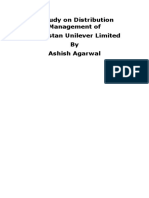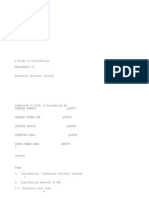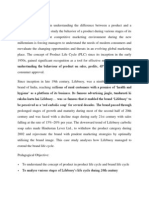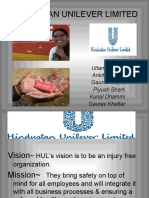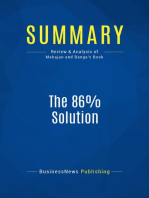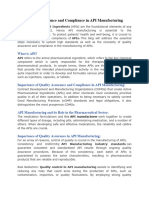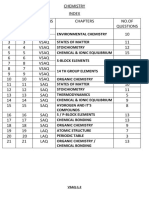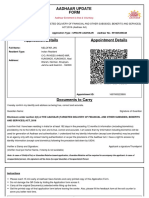Cases RSM
Cases RSM
Uploaded by
Prateek MaheshwariCopyright:
Available Formats
Cases RSM
Cases RSM
Uploaded by
Prateek MaheshwariOriginal Title
Copyright
Available Formats
Share this document
Did you find this document useful?
Is this content inappropriate?
Copyright:
Available Formats
Cases RSM
Cases RSM
Uploaded by
Prateek MaheshwariCopyright:
Available Formats
Share with:
facebook | email | print
Key Takeaway
Keep your pulse on where your customers are purchasing your products through regular market surveys. Design your distribution strategy to allow for future evolution as the market changes. Hindustan Unilever Limited (HUL) is Indias largest Fast Moving Consumer Goods company, touching two out of three Indians with their large brand portfolio. HULs products are household names across the country and span a host of categories such as soaps, detergents, personal products, tea, coffee, ice cream, and culinary products. Today, there are over 7.7 million retail outlets in India with an average of 6.8 stores per thousand people the highest store density in the world. To maintain their market leadership, HUL pursues innovative distribution mechanisms to reach the millions of potential consumers in both urban areas and small remote villages where there is no retail distribution network, no advertising coverage, and poor roads and transport. HUL realized from the onset that its sales and distribution network gave it an edge over the competition, but that rivals would try to match it over time. To maintain their competitive advantage, HUL has aggressively extended more deeply in India, moving from large to small towns, and from urban to semi-urban areas. The unorganized and scattered character of markets in India means sales and distribution requires a different tactic from that of more developed economies. Like Coca-Cola, HUL knew it needed to tailor its approach for the different markets.
Modern Trade
Photo Credit: Hindustan Unilever
Modern trade, or retail chains, is characterized by standardized store formats, airconditioned ambiance, and a variety of goods and typically lower pricing. Global retail chains such as Walmart and Carrefour fall under this category. In India, modern trade comprises roughly 10% of all commercial transactions and is growing rapidly. In the past, HULs sales forces were separated by geographies and product categories. However, this organizational structure was ill equipped to manage modern trade, as one regional team negotiating the terms of trade with an individual franchisee of a national retail chain could never be as effective as HUL entering a long-term comprehensive contract spanning all product categories and outlets of the retail chain. Today, HUL has specific account managers dedicated to large modern trade customers.
General trade
Photo Credit: CGAP
General trade consists of the thousands of independent retail and wholesale outlets across the country. Often called mom and pop shops, each of these stores is considered a distinct customer and has to be addressed individually. HUL services these outlets through a network of 2,900 stockists. Goods are sent to a local warehouse or carrying and forwarding agent (CFA), and are then stocked and dispatched to specific retailers upon orders from the HUL stockists. The stockists are responsible for servicing all the small retail outlets in a specific geographic area. General trade makes up the majority of HULs sales.
Rural Markets
While general trade encompasses both urban and rural markets, serving customers in more remote areas of India poses unique challenges. Rural markets are scattered over large areas with low per capita consumption rates. While the aggregate potential of rural markets is large, the potential of each of the 600+ dispersed markets is very low. As well, rural markets are not connected to urban centers by air or rail, with road connectivity poor at best. Accessing these markets, even when feasible, means additional logistics costs to HUL. Despite the roadblocks, conquering the rural markets is a must for HUL. One out of every eight people on this planet lives in an Indian village. In comparison to the urban market, which consists of roughly 250 million people, the rural market is 775 million people across 638,000 villages. Within ten years, per household consumption in rural India is forecasted to equal todays urban levels. To penetrate the rural markets, HUL launched a unique four tier distribution system. Markets were segmented based on their accessibility and business potential.
1. Direct Coverage: HUL appointed a common stockist to service all outlets within a town and sell a limited selection of the brand portfolio. Towns consisted of populations of under 50,000 people. 2. Indirect Coverage: HUL targeted retailers in accessible villages close to larger urban markets. Retail stockists were assigned a permanent route to ensure that all accessible villages in the vicinity were served at least once a fortnight. 3. Streamline: Streamline leveraged the rural wholesale channel to reach markets inaccessible by road. Star Sellers were appointed among wholesalers in a particular village. Star Sellers would purchase stock from a local distributor and then distribute stock to retailers in smaller villages using local means of transport (e.g. motorcycles, rickshaws). 4. Project Shakti: Project Shakti targeted the very small villages (<2,000) and tapped into pre-existing womens self help groups (SHG). Underprivileged rural women were invited to become direct-to-consumer sales distributors for HUL products. Termed Shakti Ammas (literally strength mothers), these women represent HUL and sell its home-care, health, and hygiene products in their villages. By the end of 2009, Project Shakti network comprised of 45,000 Shakti Ammas covering 100,000 villages across 15 states in the country, cumulatively reaching over 3 million households every month. Unilever has replicated Project Shaktis success in other markets such as Sri Lanka and Bangladesh
Abstract:
Lifebuoy's Swasthya Chetna (LSC) was a fiveyear health and hygiene education program initiated by Hindustan Lever Limited (HLL), the Indian arm of the fast moving consumer goods (FMCG) major, Unilever. The program was formally launched in 2002, in eight states across India. The objective of this program was to educate
around 200 million people in rural and urban areas about the importance of adopting good 'health and hygiene'practices. The program spread awareness about germs and their adverse effects on health, and how proper 'health and hygiene'practices, such as bathing and washing hands with soap could prevent diseases like diarrhea. According to HLL, LSC was not a philanthropic activity, but a marketing program with a social benefit. HLL sought to grow the Lifebuoy brand in India by attracting those consumers who never used soap. In the process, the company sought to bring about a behavioral change by convincing people to use soaps more frequently, thus creating more users for its brand. This program was also seen as a successful case for public-private partnership.
Issues:
Understand the rationale behind the Lifebuoy Swasthya Chetna initiative by Hindustan Lever Limited (HLL) in India. Understand the issues related to brand management and repositioning in the personal wash soap segment in the fast moving consumer goods (FMCG) industry in India. Appreciate the role of public-private partnerships as a win-win situation for private entities, governments, and individual consumers.
Contents:
Page No. 1 2 3 5 6 9 10 10 11 12 14
Introduction Background Note Lifebuoy and Health Initiating a Behavior Change A Multi-Phase Interactive Program Impact of the Program The Accolades Some Criticisms Other Initiatives for Lifebuoy Outlook Exhibits
Keywords:
Lifebuoy's Swasthya Chetna, Hindustan Lever Limited (HLL), Unilever, Fast moving consumer goods (FMCG) major, Personal Soap Wash, Rural Social Marketing Strategy, Advertising Campaign , Sales Promotion, Marketing Mix, Brand Management, Repositioning , Behavioral change, Corporate Social Responsibility, Media Channels, Global Public-Private Partnership for Handwashing with soap (GPPP-HW)
Lifebuoy Leaves its Stamp on India Contd...
And we are working with parents and children, health educators, teachers, community leaders, and government agencies to spread the word,5said Caroline Harding, Global Brand Director, Health Brands, Unilever. In the process, HLL sought to increase the sales of Lifebuoy soaps by convincing these people to use soaps more frequently and also to create new users for its brand. HLL launched the LSC program in villages where media penetration was negligible. The people of these villages were educated through lectures, demonstrations, visual aids such as flip charts and interactive quizzes. Various media vehicles were used in the program including cinema vans, wall paintings, weekly markets, fairs, and festivals. The initiative started with communication to schoolchildren, which was extended to their parents and other adults, and culminated in the formation of sustainable health clubs by the local people. The whole process took around two to three years. HLL had committed US$ 5.4 million for this fiveyear program.6 The program was implemented by Ogilvy Outreach7, while Weber Shandwick (WS),8one of the largest public relations (PR) agencies in the world, provided the PR support. By the end of 2005, HLL had covered more than 18,000 villages in these eight states. The sales of Lifebuoy grew by 20 percent in 2003-04 with strong sales reported from the eight states where the program was being implemented. In 2005, the Lifebuoy brand grew by 10 percent and this growth was expected to continue in 2006. The program also received a lot of positive media attention...
Background Note
Hindustan Vanaspati Manufacturing Company, the first Indian subsidiary of Unilever was established in 1931. (Refer to Exhibit III for a brief note on Unilever). However, many of Unilever's popular brands like 'Lifebuoy', 'Pears', 'Lux', 'Vim', and 'Dalda'were already available in India...
Lifebuoy and Health
Lifebuoy was initially launched in India in 1895, within one year of its launch in the UK. It was the flagship soap brand of Unilever (Refer to Exhibit V for Lifebuoy's logo). In the 1930s, Unilever started the Clean hands help guard health campaign in the US to encourage consumers to make their hands germ-free by using Lifebuoy...
Initiating a Behavior Change
It is estimated that across the world, diarrhea results in the death of about 3 million children each year. In India, around 600,000 children die every year on account of diarrhea. Diseases like diarrhea also lead to loss of workdays that directly affect labor productivity in rural India...
A Multi-Phase Interactive Program
Initially, the objective of trying to change the behavior and attitudes of rural consumers proved to be a tough challenge...
Impact Of The Program
In 2003-04, the sales of Lifebuoy grew by 20 percent. According to Unilever, the sales of Lifebuoy were showing directly attributable growth as sales from the eight states where the program operated was particularly strong...
Excerpts Contd... The Accolades
On the whole, the program received positive coverage by the national as well as international media. The Financial Times reported, New distribution channels have been developed for the (LSC) program, with representatives that are part salespeople, part health workers sent to villages to teach schoolchildren the importance of hand washing with soap...
Some Criticisms
In early 2001, HLL initiated a handwashing program in Kerala as part of the GPPP-HW. But its initiative in Kerala faced protests from some anti-globalization activists...
Other Initiatives for Lifebuoy
The handwashing campaign was extended to urban areas in August 2003 with the Healthy Hindustan campaign. For this, HLL partnered with McDonald's Western India across cities like Mumbai, Pune, Ahmedabad, and Vadodara to educate children about the benefits of handwashing with soap...
Outlook
By 2005, LSC was regarded as India's single largest health and hygiene education program. Changing the behavior of people, particularly in the rural areas was a big challenge for LSC, as these behaviors were deeply rooted...
Exhibits
Exhibit I: Lifebuoy Swasthya Chetna Postal Cover Exhibit II: Lifebuoy Swasthya Chetna Logo Exhibit III: A Brief Note on Unilever Exhibit IV: List of HLL's Brands Exhibit V: Lifebuoy logo Exhibit VI: Pack-Shots of Lifebuoy Soaps Exhibit VII: A Public-Private Partnership for Handwashing Exhibit VIII: Campaigning for Health & Hygiene Exhibit IX: Glo-germ Demonstrations Exhibit X: Wall Painting of Lifebuoy
You might also like
- HUL Distribution ModelDocument19 pagesHUL Distribution ModelArpan Mehra93% (71)
- HUL, ITC & Godrej (Supply Chain Management Comparision)Document39 pagesHUL, ITC & Godrej (Supply Chain Management Comparision)Jeetesh Kumar92% (12)
- HUL S&D ManagementDocument21 pagesHUL S&D ManagementKuldipak KheradiyaNo ratings yet
- Lifebuoy - CSRDocument16 pagesLifebuoy - CSRDatthu GundlapalliNo ratings yet
- Marketing 3.0: From Products to Customers to the Human SpiritFrom EverandMarketing 3.0: From Products to Customers to the Human SpiritRating: 4.5 out of 5 stars4.5/5 (29)
- The Long Tail (Review and Analysis of Anderson's Book)From EverandThe Long Tail (Review and Analysis of Anderson's Book)Rating: 4.5 out of 5 stars4.5/5 (2)
- The Disruptors 2: How Social Entrepreneurs Lead and Manage DisruptionFrom EverandThe Disruptors 2: How Social Entrepreneurs Lead and Manage DisruptionNo ratings yet
- Hul Rural StrategyDocument12 pagesHul Rural Strategyxgame2100% (1)
- Rural StrategyDocument18 pagesRural StrategyMithesh WaingankarNo ratings yet
- Hindustan Unilever Limited Geographical CoverageDocument3 pagesHindustan Unilever Limited Geographical CoverageHarish Chandra JoshiNo ratings yet
- MM CASE ASSIGNMENT On Unilever in India Hindustan Levers Project Shakti by PGP - 26 - 112 Sourav AnandDocument4 pagesMM CASE ASSIGNMENT On Unilever in India Hindustan Levers Project Shakti by PGP - 26 - 112 Sourav AnandSOURAV ANANDNo ratings yet
- M C CC C CC C CDocument6 pagesM C CC C CC C CAmulya SharmaNo ratings yet
- A Study On Distribution Management of Hindustan Unilever Limited by Ashish AgarwalDocument32 pagesA Study On Distribution Management of Hindustan Unilever Limited by Ashish AgarwalAshish AgarwalNo ratings yet
- HULDocument3 pagesHULVenkat KrishnanNo ratings yet
- Company ProfileDocument4 pagesCompany ProfileTanvi KatariaNo ratings yet
- How Unilever Reaches Rural Consumers in Emerging MarketsDocument6 pagesHow Unilever Reaches Rural Consumers in Emerging MarketsĐỗ Ngọc Huyền TrangNo ratings yet
- Competitive Strategies of HULDocument13 pagesCompetitive Strategies of HULankitpnani100% (1)
- Hindustan Unilever Limited: Distribution System of HULDocument3 pagesHindustan Unilever Limited: Distribution System of HULRushabh JadavNo ratings yet
- Presented By:: Makshud Khan MBA 3 Sem Nims University, JaipurDocument34 pagesPresented By:: Makshud Khan MBA 3 Sem Nims University, Jaipurmakshudkhan83% (6)
- Distribution Management of Hindustan Unilever LTD NewDocument31 pagesDistribution Management of Hindustan Unilever LTD NewNachiket JaniNo ratings yet
- Executive SummaryDocument65 pagesExecutive SummaryRachna IyerNo ratings yet
- Concept Paper: Mission StatementDocument7 pagesConcept Paper: Mission StatementManish Kumar PathakNo ratings yet
- Marketing Strategy of FMCG Product: A Case Study of Hindustan Unilever LimitedDocument3 pagesMarketing Strategy of FMCG Product: A Case Study of Hindustan Unilever LimitedSundaramNo ratings yet
- A Study On Distribution Strategies of Hindustan Unilever Limited by Rajnikant GharatDocument31 pagesA Study On Distribution Strategies of Hindustan Unilever Limited by Rajnikant GharatRajnikant GharatNo ratings yet
- Marketing AssignmentDocument3 pagesMarketing AssignmentMuktha MohanNo ratings yet
- Click To Edit Master Subtitle Style: Presented By:Ishank Richa SwatiDocument34 pagesClick To Edit Master Subtitle Style: Presented By:Ishank Richa Swatirn44809No ratings yet
- Deo Avishek - Mba-40031-24Document19 pagesDeo Avishek - Mba-40031-24deoavishekdNo ratings yet
- Sem 5 Sle GRP 11 Logi Report On HulDocument61 pagesSem 5 Sle GRP 11 Logi Report On HulHusain ShiyajiNo ratings yet
- A Project Report On HulDocument20 pagesA Project Report On HulKamakshi BakshiNo ratings yet
- Perfetti & HULDocument2 pagesPerfetti & HULSudhir ChoudharyNo ratings yet
- Abstract LifebuoyDocument9 pagesAbstract LifebuoyShlok MalhotraNo ratings yet
- Indian Institute of Planning and Management: New DelhiDocument33 pagesIndian Institute of Planning and Management: New DelhiDip RanjanNo ratings yet
- National Institute of Fashion Technology, Kolkata: Minor Project SynopsisDocument13 pagesNational Institute of Fashion Technology, Kolkata: Minor Project SynopsisJatin BhatiaNo ratings yet
- Case Study LifebouyDocument9 pagesCase Study LifebouyAyush Singla100% (1)
- Distribution Strategy of Hul of Existing ProductsDocument4 pagesDistribution Strategy of Hul of Existing ProductsMahak Gupta Student, Jaipuria LucknowNo ratings yet
- Hindustan Unilever Limited: Uttam Kotdiya Ankit Agarwal Gaurav Gupta Piyush Bharti Kunal Dhammi Gaurav KhattarDocument25 pagesHindustan Unilever Limited: Uttam Kotdiya Ankit Agarwal Gaurav Gupta Piyush Bharti Kunal Dhammi Gaurav KhattaruttamkotdiyaNo ratings yet
- Unilever in India: Business and Growth - Material For Study and DiscussionDocument5 pagesUnilever in India: Business and Growth - Material For Study and DiscussionAzad KrishanNo ratings yet
- Study On SHG in Rural MarketDocument60 pagesStudy On SHG in Rural MarketspindujaNo ratings yet
- HulDocument13 pagesHulAmanBhatnagar75% (4)
- Sales and Distribution of HULDocument17 pagesSales and Distribution of HULAnkit Patodia100% (1)
- Rural Marketing Initiatives by Companies in IndiaDocument86 pagesRural Marketing Initiatives by Companies in IndiaAkash Rajput92% (37)
- Rural Marketing ProjectDocument21 pagesRural Marketing ProjectSurpreet Singh PaviNo ratings yet
- Rural Marketing Case StudiesDocument6 pagesRural Marketing Case StudiesRupesh MalikNo ratings yet
- HUL CaseDocument3 pagesHUL CaseRitik Maheshwari100% (1)
- Hul StrategyDocument10 pagesHul StrategyNikhil JainNo ratings yet
- "Integrated Marketing Communication" of LUXDocument42 pages"Integrated Marketing Communication" of LUXLalit Kothari75% (8)
- Abstract 1Document25 pagesAbstract 1Elakkiya INo ratings yet
- NAVYA S-A0102219128-BOP Psda 1Document4 pagesNAVYA S-A0102219128-BOP Psda 1Amartya SrivastavaNo ratings yet
- Hindustan Unilever Case Study On The Social MarketplaceDocument2 pagesHindustan Unilever Case Study On The Social MarketplaceHi GNo ratings yet
- BH WriteupDocument1 pageBH Writeup51SMRITI KUMARINo ratings yet
- Unilever in Emerging MarketsDocument2 pagesUnilever in Emerging Marketsmylb22402caNo ratings yet
- Unilever in India - Project ShaktiDocument4 pagesUnilever in India - Project ShaktiRafaa Dalvi0% (1)
- The 86% Solution (Review and Analysis of Mahajan and Banga's Book)From EverandThe 86% Solution (Review and Analysis of Mahajan and Banga's Book)No ratings yet
- The Grocery Store Bible: A Beginner's Guide To Understanding And Running A Grocery Store SuccessfullyFrom EverandThe Grocery Store Bible: A Beginner's Guide To Understanding And Running A Grocery Store SuccessfullyNo ratings yet
- DK Essential Managers: Doing Business in India: Culture, Travel, Negotiating, Etiquette, RelationshipsFrom EverandDK Essential Managers: Doing Business in India: Culture, Travel, Negotiating, Etiquette, RelationshipsNo ratings yet
- Inclusive Business in Financing: Where Commercial Opportunity and Sustainability ConvergeFrom EverandInclusive Business in Financing: Where Commercial Opportunity and Sustainability ConvergeNo ratings yet
- Internship ReportDocument8 pagesInternship Reporteasy medicineNo ratings yet
- Symptoms of Dyslexia Screening ChecklistDocument7 pagesSymptoms of Dyslexia Screening Checklistsunnycoco100% (1)
- 1034-Article Text-6789-1-10-20191218Document17 pages1034-Article Text-6789-1-10-20191218John Patrick MarquezNo ratings yet
- MOS Course OutlineDocument3 pagesMOS Course OutlineRachit MaheshwariNo ratings yet
- اوراق مواد امريكاDocument2 pagesاوراق مواد امريكاsadallah71No ratings yet
- Ulcerativecolitis 170323180448 PDFDocument88 pagesUlcerativecolitis 170323180448 PDFBasudewo Agung100% (1)
- Turner V MorganDocument2 pagesTurner V MorganAarav RamcharitarNo ratings yet
- Incident in The ParkDocument4 pagesIncident in The ParkJacy VykeNo ratings yet
- Internship Report 2Document57 pagesInternship Report 2selvathamizh27No ratings yet
- Affect and Biopower: Towards A Politics of LifeDocument16 pagesAffect and Biopower: Towards A Politics of LifeJose RomeroNo ratings yet
- Quality Assurance and Compliance in API ManufacturingDocument5 pagesQuality Assurance and Compliance in API ManufacturingJonayed Hossain SarkerNo ratings yet
- MOTOR and MEPDocument46 pagesMOTOR and MEPAbhirup BandyopadhyayNo ratings yet
- State Bank of India - Parivartan: Case StudyDocument4 pagesState Bank of India - Parivartan: Case StudyKunal BagdeNo ratings yet
- Pine Q6Document4 pagesPine Q6Keith WaldenNo ratings yet
- Alexa Loses Her VoiceDocument5 pagesAlexa Loses Her Voiceapi-462289983100% (2)
- AZ 140T00A ENU TrainerPrepGuideDocument7 pagesAZ 140T00A ENU TrainerPrepGuideVasilios DourosNo ratings yet
- Chemistry Previous PaperDocument14 pagesChemistry Previous PaperK Vishnu Vardhan ReddyNo ratings yet
- Lighting and Sound in FilmsDocument4 pagesLighting and Sound in Filmsapi-526939534No ratings yet
- Reading Focus: SpeakingDocument8 pagesReading Focus: SpeakingJulianaNo ratings yet
- 10 PHP MVC Frameworks Templating and FormsDocument28 pages10 PHP MVC Frameworks Templating and FormsNguyen Tuan Kiet (FGW DN)No ratings yet
- Material Item Specification Fill Capacity: SECTION 204-04: Wheels and Tires 2014 F-150 Workshop Manual SpecificationsDocument59 pagesMaterial Item Specification Fill Capacity: SECTION 204-04: Wheels and Tires 2014 F-150 Workshop Manual SpecificationsHenry SilvaNo ratings yet
- Billions Club - How To Pass A Trading ChallengeDocument58 pagesBillions Club - How To Pass A Trading ChallengeamanipaularthurNo ratings yet
- Cfe2 e 30 Mothers Day Powerpoint - Ver - 1Document14 pagesCfe2 e 30 Mothers Day Powerpoint - Ver - 1English TimeNo ratings yet
- Huawei AR2200 SeriesDocument2 pagesHuawei AR2200 SeriesComptest Polska Sp z o oNo ratings yet
- Sanborn Response WilliamsonDocument8 pagesSanborn Response WilliamsonAnonymous HtDbszqtNo ratings yet
- Soa Abgor0pl00000057xxxx 04072023 1688456734739-1Document5 pagesSoa Abgor0pl00000057xxxx 04072023 1688456734739-1Om PrakashNo ratings yet
- Block 1 PDFDocument73 pagesBlock 1 PDFShubhendu ChattopadhyayNo ratings yet
- Copia de Art History Thesis - by SlidesgoDocument89 pagesCopia de Art History Thesis - by SlidesgoSOFIA ASTRID LINO GONZALEZNo ratings yet
- CAB v. Delta Air Lines, Inc., 367 U.S. 316 (1961)Document24 pagesCAB v. Delta Air Lines, Inc., 367 U.S. 316 (1961)Scribd Government DocsNo ratings yet
- Aadhaar Update Form: Aadhaar Enrolment Is Free & VoluntaryDocument4 pagesAadhaar Update Form: Aadhaar Enrolment Is Free & VoluntaryPak or Ind cricket newsNo ratings yet













